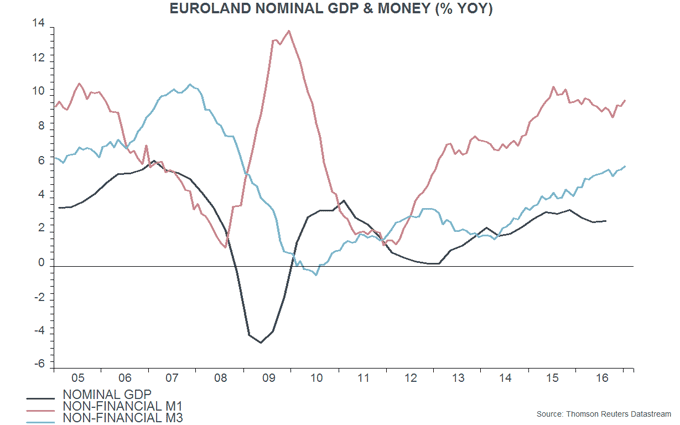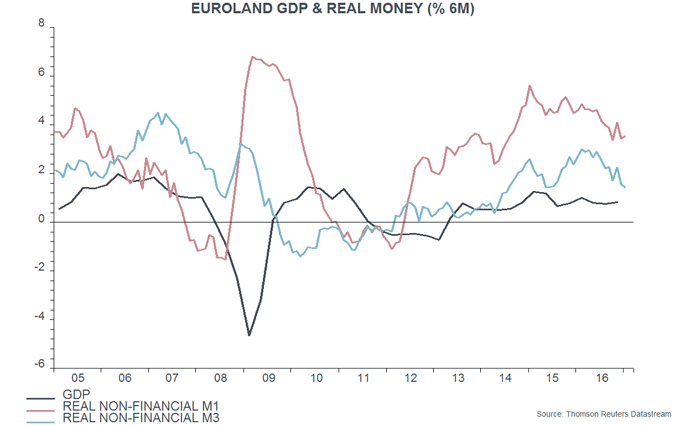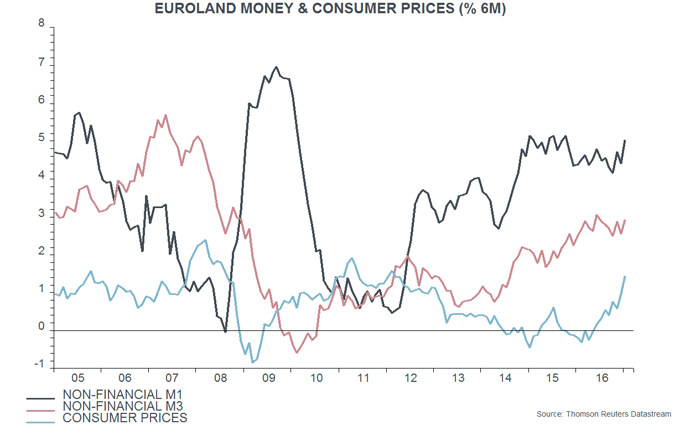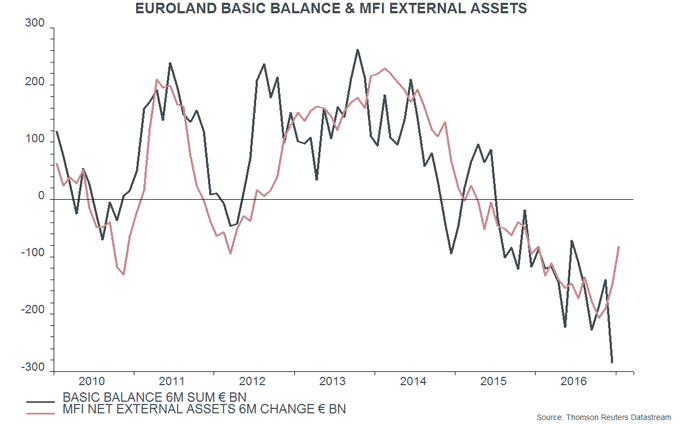Entries from February 1, 2017 - February 28, 2017
Eurozone money trends suggesting stable growth, rising inflation
Eurozone economic news remains solid – the Markit composite PMI output index, for example, reached its highest level since 2011 in February, moving above the corresponding US index. Robust economic performance was predicted by monetary trends last year (e.g. here). Nominal money growth remains strong but rising inflation has moderated real expansion. Current trends suggest that economic growth will continue at a respectable pace while “core” inflation will follow headline inflation higher later in 2017.
The preferred narrow and broad monetary aggregates here are non-financial M1 and M3, comprising money held by households and non-financial corporations – the headline M1 / M3 measures additionally include financial corporations’ holdings but these contain little information about near-term economic prospects. Annual growth of non-financial M1 rose to 9.7% in January, a nine-month high, while growth of non-financial M3 reached 5.9%, the highest since 2008. The recent increases suggest that annual growth of nominal GDP will pick up during 2017 – see first chart.
The preferred monetary measure here for forecasting fluctuations in economic activity is the six-month rate of change of real (i.e. consumer-price-deflated) non-financial M1. This has moderated since the first half of 2016 but remains solid by historical standards and was little changed in January – second chart. The slowdown in recent months has been entirely due to rising inflation, with six-month nominal growth moving higher – third chart.

Six-month real non-financial M1 growth is around the middle of its range over the past three years, a period during which GDP expansion has averaged 1.7% per annum – a reasonable expectation for the pace of growth over the next two to three quarters. Such growth would be above “potential” economic expansion estimated by the EU Commission, IMF and OECD at 1.0-1.2% in 2017, implying a further fall in unemployment.
Rising nominal money growth, meanwhile, suggests that stable real economic expansion will be accompanied by higher inflation, as measured by the GDP deflator – the broadest measure of domestic prices. Faster growth in the GDP deflator would be expected to be associated with a rise in “core” consumer price inflation (i.e. excluding energy, food, alcohol and tobacco) – fourth chart.
A recent post noted that the euro exchange rate was depressed in 2016 by a record outflow of direct and portfolio investment – this outflow swamped a rising current account surplus, resulting in a large “basic balance” deficit. The post suggested that the outflow would slow in 2017, partly reflecting QE “tapering”, supporting the euro. This slowdown may have begun, judging from data on the net external asset position of monetary financial institutions (MFIs): the change in such assets mirrors the basic balance and the decline in the six months to January was the smallest for a year – fifth chart.
Is G7 core inflation about to break higher?
G7 headline consumer price inflation is rising sharply but “core” inflation – excluding food and energy prices – remains close to its average in recent years. Core inflation may increase in 2017-18, reflecting low G7 unemployment, “second-round” effects from the reversal in commodity prices and a permissive monetary environment. Higher core inflation may result in monetary authorities tightening policy later in 2017 despite a slowdown in economic growth (suggested by recent monetary trends – see previous post).
G7 headline CPI inflation rose to 1.8% in January, the highest since July 2014 and up from a low of zero in September 2015. Core inflation, however, was unchanged at 1.5%, close to its average of 1.4% over the last five years (i.e. 2012-16) – see first chart.
The headline / core gap is closely correlated with the annual rate of change of the S&P GSCI commodity price index. This relationship suggests that the gap will rise from 0.3 percentage points (pp) in January to about 1 pp in spring 2017 – second chart. Headline inflation, therefore, may increase to about 2.5%, assuming a stable core rate. The gap will decline later in 2017 if the GSCI index stabilises – but current economic strength could result in a further gain.

Monetary policies are likely to key off core rather than headline inflation developments. G7 core inflation may rise in 2017-18, for three reasons. First, core inflation has increased historically when the G7 unemployment rate has fallen below 6% – third chart. The rate moved below this level in March 2015; core inflation has risen by 0.2 pp since then (i.e. from 1.3% to 1.5%). The jobless rate was 5.3% in December 2016, equal to the low reached in the 2000s (2007), and may decline further in lagged response to current economic strength.

Secondly, core inflation has also risen on average historically after the headline / core gap has turned positive – fourth chart. Stronger commodity prices boost input costs for producers of core consumer goods and services, while higher headline inflation may feed back into increased wage demands. Core inflation rose significantly when a large headline / core gap last opened up in 2010-11, despite a high unemployment rate.

Thirdly, G7 narrow money has been growing strongly in recent years, suggesting a loose monetary environment that may accommodate rising core inflation. The trend decline in nominal GDP expansion between the 1970s and the 2000s reflected progressively lower peaks and troughs in narrow money growth – fifth chart. Average money growth since 2010 has exceeded the decade averages – shown by the horizontal lines in the chart – for the 1980s, 1990s and 2000s.

Global money trends suggesting rising economic / market risks
Global six-month real narrow money growth appears to have stabilised in January after a sharp fall in late 2016. The recent slowdown suggests that global economic momentum will cool from spring 2017, while the liquidity backdrop for markets has deteriorated.
As previously discussed, the global (i.e. G7 plus emerging E7) narrow money measure tracked here has been depressed recently by India’s “demonetisation” programme, which resulted in M1 falling by 28% between October and December, with a 5% recovery in January. This programme has hit Indian near-term economic prospects but the M1 decline overstates the impact, while the global implications are probably limited. A decision, therefore, was taken to exclude the contraction from the global narrow money measure by recalculating the aggregate keeping Indian M1 at its October level.
Even with this adjustment, global real narrow money has slowed sharply in recent months – six-month growth peaked at 5.5% (not annualised) in August 2016 and is estimated to have fallen to 2.9% in January, based on data for countries comprising two-thirds of the aggregate. Current expansion is the lowest since October 2015 – see first chart.
Turning points in global real narrow money growth have led those in industrial output or GDP growth by an average of nine months historically, with a normal range of six to 12 months. Global real money growth bottomed in August 2015, rising strongly over the subsequent year. Industrial output momentum started to pick up nine months later, i.e. from May 2016.
Based on the nine-month average lead, the fall in global real narrow money expansion since August 2016 suggests that economic growth will peak in May 2017 and decline through October. A turning point, however, could occur as early as February or as late as August. An early peak (i.e. before April) is less likely because growth of the non-monetary global leading indicator tracked here (based on the OECD’s country leading indicators) was still rising in December 2016 and has led economic growth turning points by four to five months on average historically – see previous post.
Roughly 70% of the fall in global six-month real narrow money growth since August 2016 can be attributed to a decline in nominal monetary expansion, with the remaining 30% due to higher inflation – second chart. The fall has been broadly based across countries, with the US and China making significant negative contributions – third chart.

Chinese six-month real narrow money growth fell to a 17-month low in January but remains solid by historical standards. Narrow money data can be volatile around the New Year holiday and it is possible that the January decline will be reversed, at least partially, in February. Real broad money growth was stable in January – fourth chart. The Chinese economy is expected here to perform robustly through summer 2017, at least.
US six-month real narrow money growth fell sharply into December 2016 but recovered in January. This recovery is expected here to be reversed in February: the weekly data tailed off at end-January and there is a significant negative base effect from a large monthly rise in August 2016. US monetary trends, therefore, continue to question consensus optimism about economic prospects.
UK inflation pick-up on track, target shift to CPIH likely
UK CPIH inflation, which the Office for National Statistics will next month adopt as its “headline” measure, rose to 2.0% in January versus CPI inflation of 1.8% – up from 1.7% and 1.6% respectively in December. CPIH includes owner-occupiers’ housing costs, which rose by 2.5% in the year to January. Chancellor Philip Hammond is due to update the Monetary Policy Committee’s remit next month and it would be surprising and potentially confusing if he did not switch the 2% target from CPI to CPIH.
Such a change would probably have neutral or even dovish monetary policy implications. While CPIH inflation is above the CPI measure currently, this may not be the case later in 2017 – CPI inflation is expected here to move above 3% while owner-occupiers’ housing costs may continue to rise by about 2.5% per annum, and could even slow (as they are measured using the “rental equivalence” approach and actual rents increased by only 1.2% in the year to January). CPIH inflation was below CPI inflation between June 2008 and May 2014 – see chart.
The rise in CPIH / CPI inflation in January was tempered by a fall in clothing / footwear inflation from 1.2% in December to zero. This reflected a sales timing effect and should be reversed swiftly – clothing / footwear import prices rose by 6% in the year to December.
The expectation here is that “core” CPI inflation – excluding energy, food, alcohol and tobacco – will move up from 1.6% in January to about 2% by the summer, while stronger energy and food prices will drive the CPI / core CPI inflation wedge above 1 percentage points, resulting in a 3% plus CPI rate.
UK growth strong at end-2016, money trends cautionary
UK December data for industrial / construction output and services turnover suggest that fourth-quarter GDP growth will be revised up to 0.7%. Investors should be wary of extrapolating current economic strength, since monetary trends have weakened recently.
The Office for National Statistics (ONS) today reported that industrial and construction output rose by 1.1% and 1.8% respectively between November and December – above estimated gains of 0.6% and 1.0% incorporated in its preliminary estimate that GDP grew by 0.6% last quarter. More importantly, the services turnover survey – also released today but ignored by most economists – suggests that output in that sector increased further in December despite a previously-reported 1.9% drop in retail sales / output; the ONS had assumed that services output would be stable at November’s level. If so, fourth-quarter GDP growth is likely to be raised to 0.7% – revised figures will be released on 22 February. Growth excluding the oil and gas sector could rise to 0.8% (0.7% currently).
The February Inflation Report projected that GDP growth would be unrevised at 0.6% in the fourth quarter and fall to 0.5% in the first quarter. Based on current evidence, the level of GDP in December may have been 0.3-0.4% above the fourth-quarter average, suggesting upside risk to the Bank’s first-quarter growth forecast.
An upward revision in fourth-quarter growth to 0.7% would imply that GDP rose by 1.3%, or 2.6% annualised, in the third and fourth quarters combined – the largest two-quarter gain since the fourth quarter of 2014. A pick-up into early 2017 had been predicted by a rise in six-month real narrow money expansion to a peak in June 2016 – see chart. It is likely that second-half GDP growth would have been significantly stronger but for the Brexit vote – see previous post.
Real narrow money growth remained solid through October but weakened in November / December, suggesting that the economy will retain momentum through the first half of 2017 but slow in the summer. A cautionary signal is also being given by a recent widening of the two-year swap spread, which – as in the US – has been inversely correlated with future economic growth in recent years.
Global leading indicator strong but momentum possibly peaking
The OECD’s country leading indicators are giving an upbeat message for the global economy in early 2017, in line with an earlier positive signal from monetary trends. The indicators have yet to confirm the suggestion from the latest monetary data that global economic momentum will fade towards mid-year.
The OECD yesterday released December data for its country leading indicators, allowing an update of the global (i.e. G7 plus emerging E7) leading indicator calculated here. Six-month growth of this indicator continued to rise in December. Allowing for an average lead time at historical turning points of four to five months, this suggests that six-month growth of industrial output will remain on an upward trend through April / May – see first chart.
As previously discussed, global real narrow money trends suggest that six-month industrial output growth will peak around May and move lower over the summer. Such a scenario would be consistent with six-month leading indicator growth peaking in December or January. The current monetary and leading indicator signals, therefore, are compatible.
While six-month leading indicator growth rose further in December, a levelling-off of the one-month increase hints that the six-month measure is approaching a top – first chart.
The OECD country details showed broad-based strength. The Chinese leading indicator, in particular, remains upbeat, with both six- and one-month growth rising further in December – second chart.

